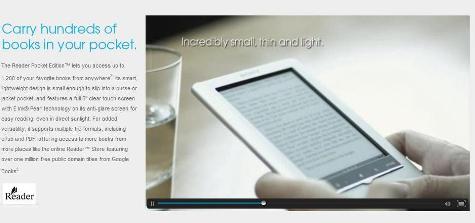No matter how slick an e-reader’s physical design, it’s hard to resist the urge to touch the screen.
Now you can easily use the screen to navigate, with the Sony Reader Pocket Edition PRS-350SC (about $199 as of October 7, 2010; the SC model is silver, while PC designates the pink version). Like its larger siblings in Sony’s latest line of e-readers, the Reader Pocket Edition employs Sony’s unique optical technology to allow fingers to tap away.
Related stories
Sony developing tablet, PlayStation-capable smartphone
Canada’s e-reader gets tough U.S. reception
How to install a touchscreen on your netbook
The Reader Pocket Edition has a 5-inch E-Ink Pearl display, the same kind of screen as on the third-generation Amazon Kindle but 1 inch smaller. Not surprisingly, the device weighs less, too: At just 5.6 ounces, the Pocket Edition is easy to hold in one hand while you’re curled up on the couch for a reading session.
The optical-technology touchscreen uses infrared sensors to detect where your finger is; it compares that information against a matrix that identifies your finger’s position and what action you are trying to accomplish, and then performs that action. The result is striking.
I found the display brighter and dramatically sharper than Sony’s previous touchscreen technology, with better contrast and clarity, as well as crisp grayscale images.
Furthermore, I could make selections with featherlight touches to the screen. Previously, Sony used a resistive touch overlay on its Touch Edition PRS-600; the effect was unfortunate, with muted responsiveness, a persistent glare, and fuzzy text.
In use, I found the touch navigation terrific and natural in feel. You simply touch to turn pages, and touch to get one of the 12 pop-up dictionaries, including conversion dictionaries for French, German, Italian, Spanish, and Dutch, plus American and British English. A simple row of buttons that lies beneath the screen consists of page-back and page-forward buttons, a zoom button, a font button, and an options button. At top is the power switch, while the built-in slim stylus is at the upper right.
Among the options is the ability to adjust the contrast and brightness ratio further–a first among the e-readers we’ve seen. You can also choose from among six font sizes, from XS to XXL. If you opt for the last of those sizes, however, expect to do an awful lot of page turns on this petite unit. People with poor eyesight would do better to consider the 6-inch Sony Reader Touch Edition PRS-650.
The unit also now charges via the increasingly common micro-USB port; previously, Sony used mini-USB. The e-reader has both Memory Stick and SD Card slots, and 2GB of on-board storage.
One of the Reader platform’s strengths is its support for the ePub e-book standard, which allows you to buy books from Sony’s own store (you upload to the device after downloading books to the Mac/PC Sony desktop client) and other stores with ePub, as well as to download books from libraries. One of its weaknesses is its pan-and-zoom approach to reading PDFs (though its PDF handling is still an improvement over that of the past).
Another weakness: No 3G or Wi-Fi. By contrast, the latest Amazon Kindle with Wi-Fi and 3G sells for just $10 more, and adds an extra inch to the screen to boot. You pay a steep price for the slick design of the highly portable Pocket Edition.
Still, among the small, 5-inch-screen e-reader set–which includes models from lesser-known makers such as Aluratek and Bookeen –Sony has leaped to the head of the pack. If you want your e-reader in a paperback size, the Sony Reader Pocket Edition is the best model you can get.





